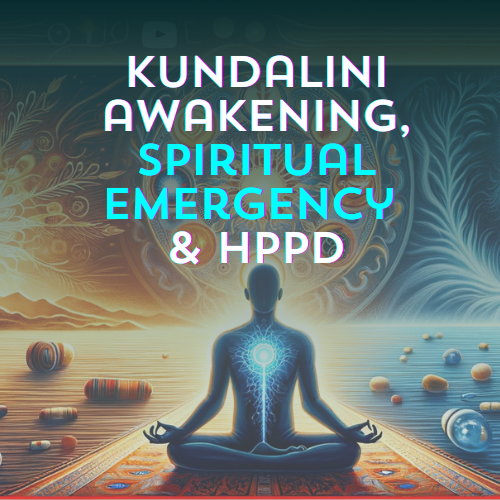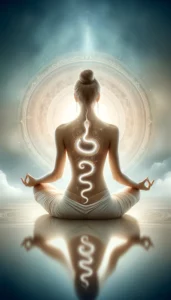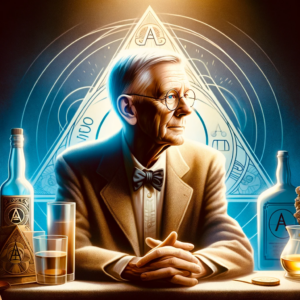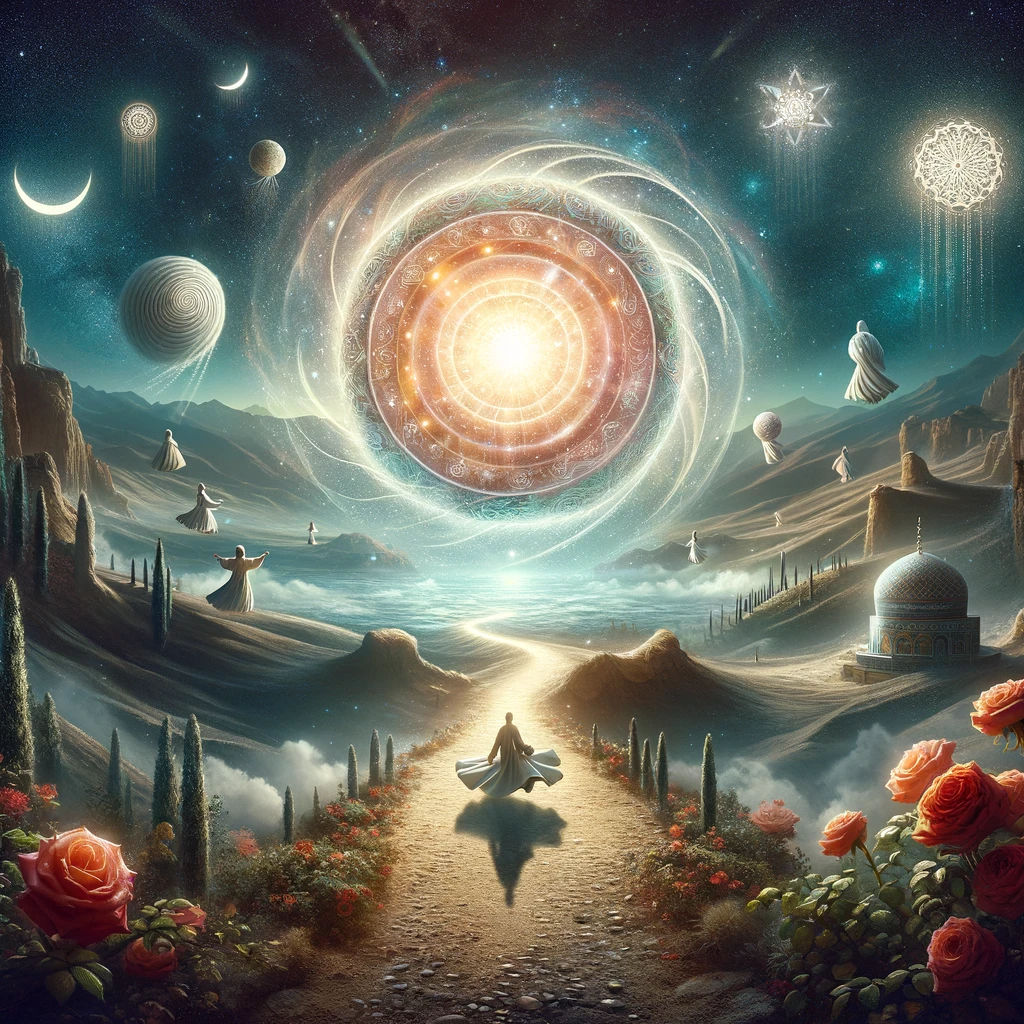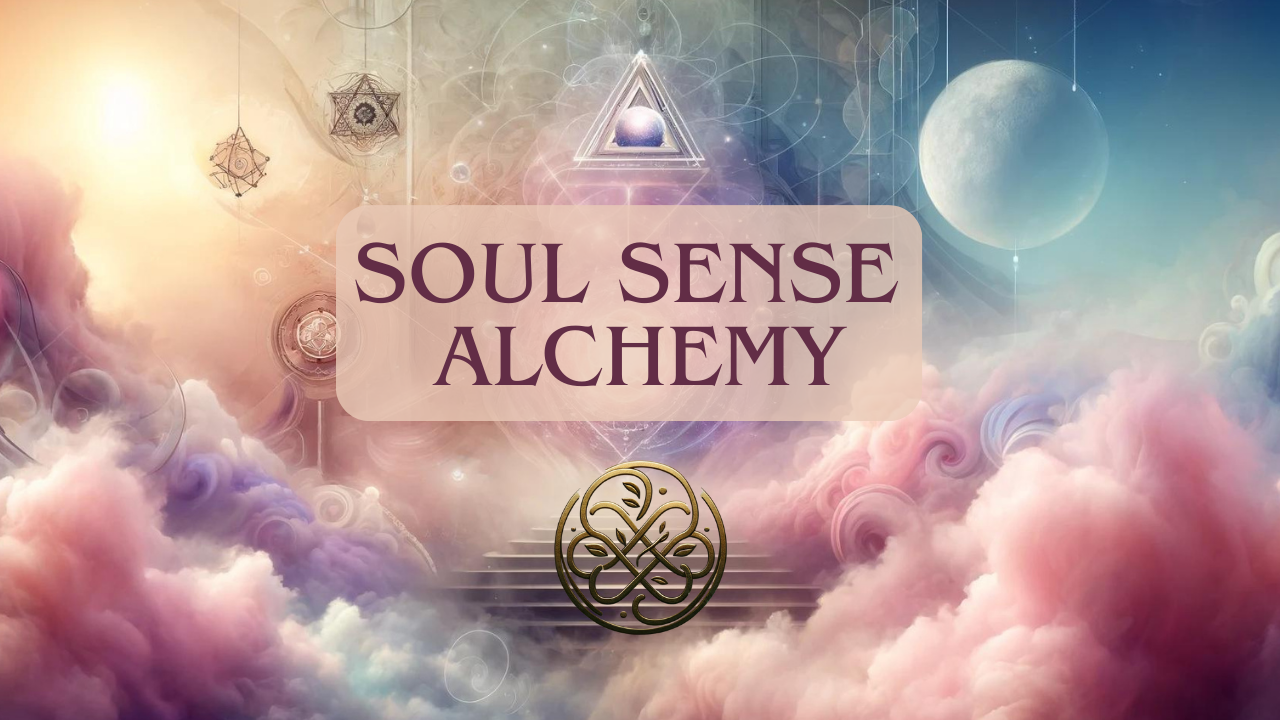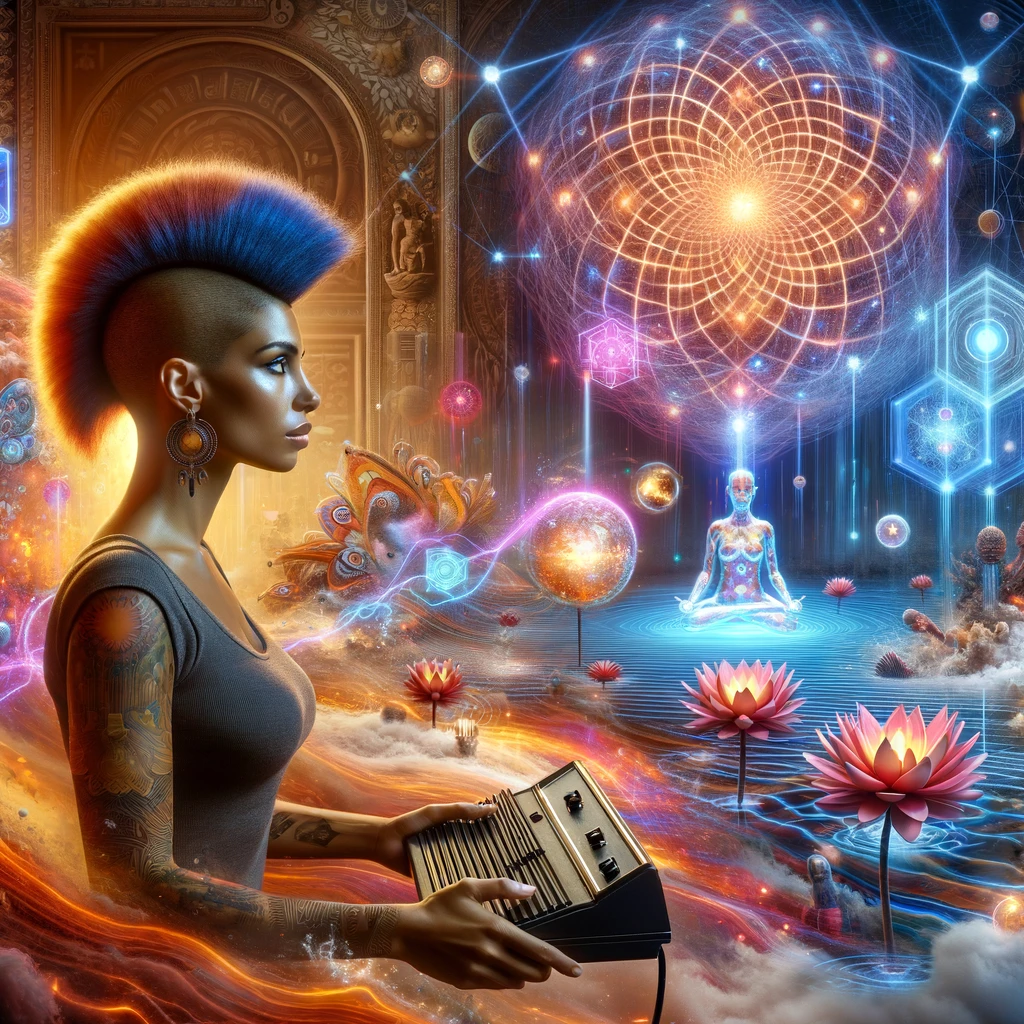As we venture into the realm of spiritual emergence, we embark on a journey that is both profoundly personal and universally resonant. My experiences, ranging from Kundalini awakenings to near-death experiences (NDEs), offer a unique perspective into the transformative power of these phenomena.
In this blog, we will explore the concept of spiritual emergence, as described by Stan and Christina Grof, delve into the insights provided by Bonnie Greenwell, and discern the differences between spiritual emergence, psychosis, and Hallucinogen Persisting Perception Disorder (HPPD).
This was covered in my course, The Ultimate Guide to Safe Psychedelic Preparation and in Sacred Psychedelic Saturday, where I answer questions about this and other topics. You can see one version of the presentation on this page or on YouTube.
Understanding Spiritual Emergence
Spiritual emergence is a term coined by Christina and Stanislav Grof to describe intense and transformative experiences that can occur spontaneously, during meditation, sexual experiences, moments of awe, or following psychedelic experiences. These experiences often lead to significant personal transformation and a deeper understanding of one’s place in the universe.
My Personal Journey of Awakening
I first experienced a Kundalini rising in 1997 during an acupuncture session! I share more about this on my YouTube channel. But my own spiritual awakening came into full force in 2005, amidst a successful but unfulfilling professional career. It was an emotional breakdown that led me to an out-of-body, near-death-like experience when I was on vacation in the South of France. This profound event was more than just a moment of crisis; it became a gateway to my spiritual awakening.
I’ve explained my awakening in my book, The Real Self Love Handbook, and in my recent TED talk.
The 11 Varieties of Spiritual Emergence
Spiritual emergencies can manifest in various forms, each offering a unique window into the soul’s journey. Here are the 11 examples that Stan and Christina Grof described:
1. Shamanic Initiation / Crisis:
This type of spiritual emergency Often manifests as a sudden and intense encounter with spiritual or mystical realms. Individuals may experience visions, hear voices, or feel as though they are receiving a spiritual calling or undergoing a profound transformation.
Elements of physical and emotional torture, death, and rebirth, as often seen in shamanic initiations. These states often involve experiences of connection with animals, plants, and elemental forces of nature.
2. Channeling / Communication with Spirit Guides:
Encounters with a being or light who shares messages received in the form of direct thought transfer or through other extrasensory means. In some instances, communication can take the form of verbal messages. Channeling these messages may occur through speaking in a trance, using automatic writing, or recording telepathically received thoughts.
Experiences of channeling can precipitate a serious psychological and spiritual crisis. One possibility is that the individual involved can interpret the experience as an indication of beginning insanity. This is particularly likely if the channeling involves hearing voices, a well-known symptom of paranoid schizophrenia.
Spirit guides are usually perceived as advanced spiritual beings on a high level of consciousness evolution, who are endowed with superior intelligence and extraordinary moral integrity. This can lead to highly problematic ego inflation in the channeler, who might feel chosen for a special mission and see it as a proof of his or her own superiority.
3. Psychic Openings / Channeling:
This encompasses experiences of suddenly gaining psychic abilities or heightened intuition. In some instances, the influx of information from non-ordinary sources, such as premonitions, precognition, telepathy, or clairvoyance, or other extrasensory perceptions.
While these abilities can be enlightening, they can also be frightening and disorienting, particularly if the individual feels they have no control over these new experiences.
Out-of-body experiences are included here. In the middle of everyday life, and often without any noticeable trigger, one’s consciousness can seem to detach from the body and witness what is happening in the surroundings of the body or in various remote locations.
People in spiritual crisis often experience uncanny coincidences that link the world of inner realities, such as dreams and visionary states, to happenings in everyday life. This phenomenon was first recognized and described by C. G. Jung, who gave it the name synchronicity.
4. UFO Encounters / Alien Abductions:
Individuals believe they have had an encounter with unidentified flying objects (UFOs) or extraterrestrial beings. These experiences often come with a profound sense of altered reality and may include vivid dreams, visions, or even physical sensations of being transported to another place or dimension.
5. Near-Death Experiences (NDEs):
This involves experiences that occur during a state of clinical death or in life-threatening situations. Individuals who have NDEs often report out-of-body experiences, traveling through a tunnel towards a light, encountering deceased loved ones, or having a split second life review. These experiences can lead to significant changes in personality and outlook on life, often leading to a reassessment of personal beliefs and priorities. This is what happened to me in 2005.
6. Kundalini Awakening:
This type of spiritual emergency involves the sudden awakening of kundalini energy, traditionally described in Eastern spiritual practices as a dormant energy at the base of the spine. When awakened, it can surge upwards through the chakras, leading to intense physical sensations, emotional upheavals, visions, and profound alterations in consciousness. It can be a deeply transformative experience but also overwhelming and disorienting without proper guidance and understanding.
7. Past-Life Experiences:
This refers to experiences where individuals feel as if they have lived previous lives. These can surface spontaneously or through practices like meditation or hypnosis. People may have vivid, detailed memories of living in different times and places. sense of remembering and reliving something that one has already seen (déjà vu) or experienced (déjà vecu) at some time in the past.
When the content of a karmic, past life experience emerges into consciousness, it can suddenly provide an explanation for many otherwise incomprehensible aspects of one’s daily life. Strange difficulties in relationships, unsubstantiated fears, and peculiar idiosyncrasies and attractions, as well as otherwise incomprehensible emotional and psychosomatic symptoms now seem to make sense as karmic carry-overs from a previous lifetime.
8. Peak Experiences:
These are usually benign and transient experiences of having a sense of being simultaneously everything and nothing. The personal identity and ego may disappear, one feels they have expanded to such an extent that our being encompasses the entire universe. These experiences often involve feelings of unity, connectedness, and a sense of the sacred. They are generally uplifting and empowering, involving a sense of ineffability and a perception of reality that is more intense and meaningful than ordinary experiences.
There is absolutely no reason why they should have adverse consequences. And yet, due to the ignorance of our culture and misconceptions of the psychiatric profession concerning spiritual matters, many people who experience such states end up hospitalized, tranquilized, and receive pathological labels.
9. The Sense of Being at the Center of a Cosmic Battle:
This type of spiritual emergency involves intense and often overwhelming experiences where the individual feels caught in a grand, cosmic struggle between forces of good and evil. It can involve themes of martyrdom, sacred marriage, and a profound sense of mission or destiny. Because of its depth and intensity, this is the type of psychospiritual crisis that is most likely diagnosed as serious mental disease.
One may experience their psyche as a colossal battlefield where a cosmic combat is being played out between the forces of Good and Evil, or Light and Darkness. They are preoccupied with the theme of death — ritual killing, sacrifice, martyrdom, and afterlife. The problem of opposites fascinates them, particularly issues related to the differences between sexes. They experience themselves as the center of fantastic events that have cosmic relevance and are important for the future of the world. Their visionary states tend to take them farther and farther back — through their own history and the history of humanity, all the way to the creation of the world and the original ideal state of paradise. In this process, they seem to strive for perfection, trying to correct things that went wrong in the past.
After a period of turmoil and confusion, the experiences become more and more pleasant and start moving toward a resolution. The process often culminates in the experience of hieros gamos, or “sacred marriage,” in which the individual is elevated to an illustrious or even divine status and experiences union with an equally distinguished partner. This indicates that the masculine and the feminine aspects of the personality are reaching a new balance. The sacred union can be experienced either with an imaginal archetypal figure, or is projected onto an idealized person from one’s life, who then appears to be a karmic partner or a soul mate.
10. Addiction as a Spiritual Emergency:
This perspective views addiction not just as a physical or psychological issue but as a crisis of the spirit. It posits that the root of addiction may lie in a deep-seated spiritual void or unaddressed existential pain, leading to substance use as an attempt to fill this void or numb the pain. Recovery, in this context, involves addressing the spiritual aspect and finding meaning and connection beyond substance use.
Check out the video about AA co-founder Bill W’s ‘white light spiritual awakening’ that led to his cure for alcoholism.
11. Possession States:
People in this type of transpersonal crisis have a distinct feeling that their psyche and body have been invaded and that they are being controlled by an evil entity or energy with personal characteristics. They perceive it as coming from outside their own personality and as being hostile and disturbing. It can appear to be a confused discarnate entity, a demonic being, or the consciousness of a wicked person invading them by means of black magic and hexing procedures.
Bonnie Greenwell’s Insights on Spiritual Emergencies
Bonnie Greenwell, a respected figure in the study of spiritual emergencies, particularly emphasizes Kundalini awakenings. She views these as potent catalysts for spiritual development. Greenwell taught that such awakenings, while challenging, are opportunities for profound personal transformation and should be approached with respect and understanding.
Differentiating Between Spiritual Emergence, Psychosis, and HPPD
One of the challenges in dealing with spiritual emergencies is differentiating them from psychiatric conditions like psychosis or disorders like HPPD. While there may be superficial similarities, spiritual emergencies often retain a level of insight and hold potential for growth and resolution, unlike the other conditions.
Bonnie’s book, The Kundalini Guide, could be very helpful to support your journey.
Hallucinogen Persisting Perception Disorder
HPPD for instance, is characterized by persistent visual disturbances and flashbacks long after the psychedelic experience has ended. It differs significantly from the growth-oriented process of spiritual emergencies.
Hallucinogen Persisting Perception Disorder, or HPPD, is a relatively rare, yet significant, condition that can occur after the use of psychedelic substances. Unlike the transformative experiences often associated with spiritual emergencies, HPPD is characterized by persistent sensory disturbances that continue long after the psychedelic experience has ended.
Key symptoms of HPPD include visual disturbances such as seeing halos or trails attached to moving objects, experiencing geometric patterns on blank surfaces, or intense visual static. Flashbacks, or spontaneous, vivid recollections of aspects of the psychedelic experience, are also common in HPPD. These symptoms can be distressing and intrusive, impacting daily functioning and quality of life.
It’s important to understand that HPPD is not about reliving the transformative or insightful parts of the psychedelic experience; rather, it’s about dealing with ongoing, often unwelcome visual anomalies. These symptoms can cause significant anxiety and may resemble those seen in neurological conditions like migraine auras or temporal lobe epilepsy, but are distinct in their association with psychedelic use.
The cause of HPPD isn’t fully understood, but it’s thought to result from changes in how the brain processes visual information. Treatment for HPPD can include medications to help manage symptoms, as well as psychotherapy to address the anxiety and disruption caused by these persistent perceptual changes.
HPPD vs. Spiritual Emergence
When comparing Hallucinogen Persisting Perception Disorder (HPPD) to spiritual emergencies, it’s crucial to recognize the fundamental differences between these two experiences. While both can follow the use of psychedelic substances, their nature, impact, and implications are distinctly different.
HPPD is characterized by chronic and intrusive sensory disturbances that are often considered unwanted and distressing. These symptoms, primarily visual in nature, persist outside the context of a psychedelic experience and do not contribute to personal growth or spiritual insight. Instead, they can be disruptive to daily life, causing significant distress and anxiety.
In contrast, spiritual emergencies, though they can be challenging and intense, are generally growth-oriented. They often involve profound psychological and spiritual transformations, leading to a deeper understanding of oneself and one’s place in the world. While they may include unusual experiences or altered states of consciousness, these are typically seen as meaningful and integral to the individual’s personal development journey.
Another key difference lies in the integration process. In spiritual emergencies, the experiences, even when difficult, can often be integrated into the individual’s life in a way that fosters personal growth and a sense of well-being. HPPD, on the other hand, often requires clinical intervention to manage the ongoing, disruptive symptoms.
Recognizing these distinctions is essential for both individuals who have used psychedelics and the professionals supporting them. Understanding whether an experience is indicative of HPPD or a spiritual emergency can guide appropriate response and care, ensuring that each individual receives the support they need for their unique situation.
Navigating a Spiritual Emergency
Dealing with a spiritual emergency requires a nuanced approach. Recognizing it as part of a spiritual journey rather than a pathological condition is crucial. Sometimes, interventions like psychiatric hospitalization or tranquilizers can exacerbate the situation. Seeking guidance from professionals well-versed in these phenomena is advisable.
Dealing with a spiritual emergency requires understanding, compassionate support, and sometimes professional guidance. Recognizing a spiritual emergency as a critical and potentially transformative part of one’s spiritual journey is the first step towards successfully working through it. These experiences, though intense and sometimes overwhelming, carry the potential for profound personal growth and spiritual awakening.
One crucial aspect of navigating a spiritual emergency is to avoid hasty pathologization or misdiagnosis. In some cases, the experiences associated with a spiritual emergency can be mistaken for psychiatric disorders, leading to unnecessary or even harmful interventions. The use of tranquilizers or psychiatric hospitalization, while well-intentioned, can sometimes exacerbate the situation, suppressing the process that needs to unfold for true healing and integration.
If you or someone you know is experiencing what seems to be a spiritual emergency, it’s essential to seek support from professionals who are well-versed in these matters. This could include therapists or counselors experienced in transpersonal psychology, spiritual guidance counselors, or practitioners trained specifically in handling spiritual emergencies. These professionals can provide the necessary understanding and support, helping to differentiate between a spiritual emergency and a mental health crisis, and guiding the individual towards appropriate care and support.
The Role of Community Support Platforms for Spiritual Emergence
In times of a difficult psychedelic experience or spiritual emergency, support platforms like the Fireside Project and Zendo Project can be invaluable. These platforms offer assistance and understanding, helping individuals navigate their experiences safely and constructively.
The Fireside Project operates a Psychedelic Peer Support Line, offering free, confidential support to individuals undergoing challenging psychedelic experiences. Their team consists of trained volunteers who provide empathetic, non-judgmental support, helping callers navigate their experiences, process emotions, and find grounding. They are accessible via phone or text at +1 623-473-7433 (62 FIRESIDE) providing a reassuring presence for those in need of immediate emotional support. The Fireside Project is an excellent resource, not just for those experiencing a bad trip, but also for individuals seeking integration support post-experience.
The Zendo Project, spearheaded by the Multidisciplinary Association for Psychedelic Studies (MAPS), provides harm reduction services at festivals and events where psychedelics are commonly used. Their approach is centered on four principles: creating a safe space, sitting, not guiding, talking through, not down, and difficult is not the same as bad. Zendo’s trained volunteers offer compassionate care and support, helping individuals transform challenging psychedelic experiences into opportunities for learning and growth. While primarily present at events, the principles and approach of the Zendo Project offer valuable insights for anyone seeking to understand and navigate difficult psychedelic experiences.
Conclusion
The journey through spiritual emergence is as challenging as it is rewarding. Understanding these phenomena, differentiating them from psychiatric conditions, and navigating them with care are crucial steps in harnessing their transformative potential. Whether through my own experiences or through guiding others, the journey of spiritual awakening continues to be a profound element of my work.
For more insights into the world of spiritual emergencies and psychedelic therapy, subscribe to my YouTube channel, where I share my experiences and expertise. Also, explore my book, “Sacred Medicine: Exploring the Psychedelic Hero’s Journey,” for personal stories and lessons from a diverse array of authors.
Remember, the path of spiritual emergence is a journey of self-discovery and transformation – one that can reshape your understanding of your world. For support in preparing for psychedelic journeys, join The Ultimate Guide to Safe Psychedelic Preparation.
